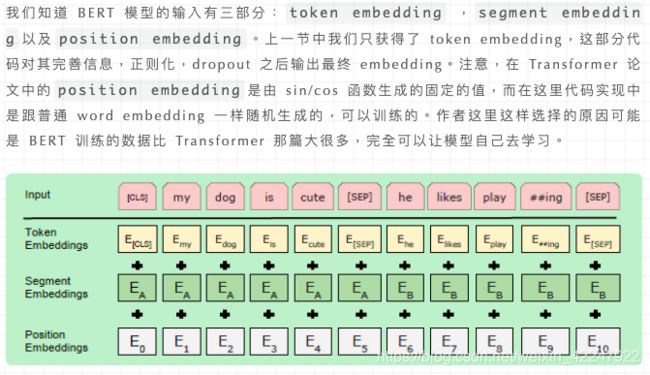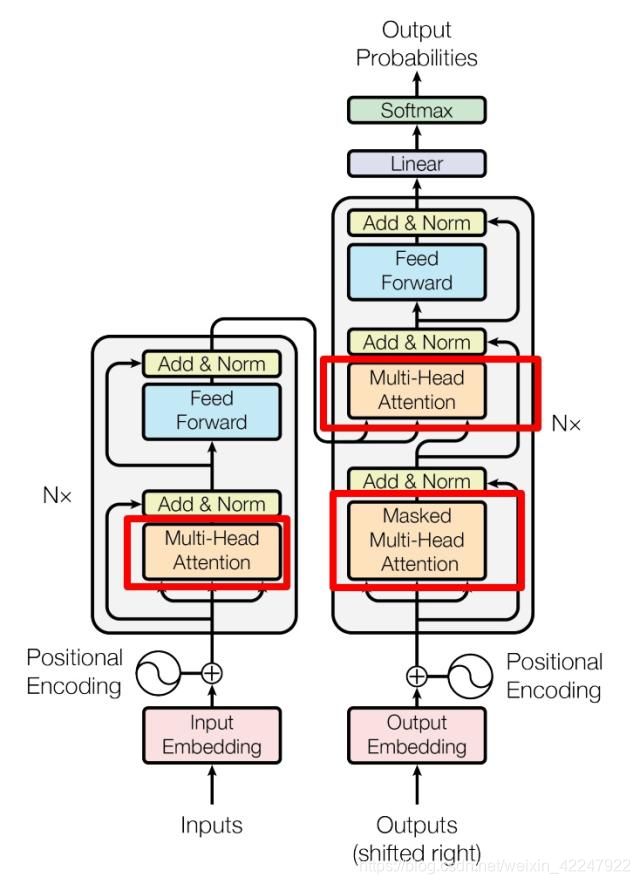NLP------ BERT源码分析(PART I)
注意,阅读源码前需要对NLP相关知识有所了解,比如attention机制、transformer 框架以及python和TensorFlow基础等。
以下要介绍的是BERT最主要的模型实现部分------BertModel,代码位于
modeling.py 模块
1、配置类(BertConfig)
class BertConfig(object):
"""BERT模型的配置类."""
def __init__(self,
vocab_size,
hidden_size=768,
num_hidden_layers=12,
num_attention_heads=12,
intermediate_size=3072,
hidden_act="gelu",
hidden_dropout_prob=0.1,
attention_probs_dropout_prob=0.1,
max_position_embeddings=512,
type_vocab_size=16,
initializer_range=0.02):
self.vocab_size = vocab_size
self.hidden_size = hidden_size
self.num_hidden_layers = num_hidden_layers
self.num_attention_heads = num_attention_heads
self.hidden_act = hidden_act
self.intermediate_size = intermediate_size
self.hidden_dropout_prob = hidden_dropout_prob
self.attention_probs_dropout_prob = attention_probs_dropout_prob
self.max_position_embeddings = max_position_embeddings
self.type_vocab_size = type_vocab_size
self.initializer_range = initializer_range
@classmethod
def from_dict(cls, json_object):
"""Constructs a `BertConfig` from a Python dictionary of parameters."""
config = BertConfig(vocab_size=None)
for (key, value) in six.iteritems(json_object):
config.__dict__[key] = value
return config
@classmethod
def from_json_file(cls, json_file):
"""Constructs a `BertConfig` from a json file of parameters."""
with tf.gfile.GFile(json_file, "r") as reader:
text = reader.read()
return cls.from_dict(json.loads(text))
def to_dict(self):
"""Serializes this instance to a Python dictionary."""
output = copy.deepcopy(self.__dict__)
return output
def to_json_string(self):
"""Serializes this instance to a JSON string."""
return json.dumps(self.to_dict(), indent=2, sort_keys=True) + "\n"
2、获取词向量(Embedding_lookup)
def embedding_lookup(input_ids,# word_id:【batch_size, seq_length】
vocab_size,
embedding_size=128,
initializer_range=0.02,
word_embedding_name="word_embeddings",
use_one_hot_embeddings=False):
# 该函数默认输入的形状为【batch_size, seq_length, input_num】
# 如果输入为2D的【batch_size, seq_length】,则扩展到【batch_size, seq_length, 1】
if input_ids.shape.ndims == 2:
input_ids = tf.expand_dims(input_ids, axis=[-1])
embedding_table = tf.get_variable(
name=word_embedding_name,
shape=[vocab_size, embedding_size],
initializer=create_initializer(initializer_range))
flat_input_ids = tf.reshape(input_ids, [-1]) #【batch_size*seq_length*input_num】
if use_one_hot_embeddings:
one_hot_input_ids = tf.one_hot(flat_input_ids, depth=vocab_size)
output = tf.matmul(one_hot_input_ids, embedding_table)
else:# 按索引取值
output = tf.gather(embedding_table, flat_input_ids)
input_shape = get_shape_list(input_ids)
# output:[batch_size, seq_length, num_inputs]
# 转成:[batch_size, seq_length, num_inputs*embedding_size]
output = tf.reshape(output,
input_shape[0:-1] + [input_shape[-1] * embedding_size])
return (output, embedding_table)
3、词向量的后续处理(embedding_postprocessor)
def embedding_postprocessor(input_tensor,# [batch_size, seq_length, embedding_size]
use_token_type=False,
token_type_ids=None,
token_type_vocab_size=16,# 一般是2
token_type_embedding_name="token_type_embeddings",
use_position_embeddings=True,
position_embedding_name="position_embeddings",
initializer_range=0.02,
max_position_embeddings=512, #最大位置编码,必须大于等于max_seq_len
dropout_prob=0.1):
input_shape = get_shape_list(input_tensor, expected_rank=3) #【batch_size,seq_length,embedding_size】
batch_size = input_shape[0]
seq_length = input_shape[1]
width = input_shape[2]
output = input_tensor
# Segment position信息
if use_token_type:
if token_type_ids isNone:
raise ValueError("`token_type_ids` must be specified if"
"`use_token_type` is True.")
token_type_table = tf.get_variable(
name=token_type_embedding_name,
shape=[token_type_vocab_size, width],
initializer=create_initializer(initializer_range))
# 由于token-type-table比较小,所以这里采用one-hot的embedding方式加速
flat_token_type_ids = tf.reshape(token_type_ids, [-1])
one_hot_ids = tf.one_hot(flat_token_type_ids, depth=token_type_vocab_size)
token_type_embeddings = tf.matmul(one_hot_ids, token_type_table)
token_type_embeddings = tf.reshape(token_type_embeddings,
[batch_size, seq_length, width])
output += token_type_embeddings
# Position embedding信息
if use_position_embeddings:
# 确保seq_length小于等于max_position_embeddings
assert_op = tf.assert_less_equal(seq_length, max_position_embeddings)
with tf.control_dependencies([assert_op]):
full_position_embeddings = tf.get_variable(
name=position_embedding_name,
shape=[max_position_embeddings, width],
initializer=create_initializer(initializer_range))
# 这里position embedding是可学习的参数,[max_position_embeddings, width]
# 但是通常实际输入序列没有达到max_position_embeddings
# 所以为了提高训练速度,使用tf.slice取出句子长度的embedding
position_embeddings = tf.slice(full_position_embeddings, [0, 0],
[seq_length, -1])
num_dims = len(output.shape.as_list())
# word embedding之后的tensor是[batch_size, seq_length, width]
# 因为位置编码是与输入内容无关,它的shape总是[seq_length, width]
# 我们无法把位置Embedding加到word embedding上
# 因此我们需要扩展位置编码为[1, seq_length, width]
# 然后就能通过broadcasting加上去了。
position_broadcast_shape = []
for _ in range(num_dims - 2):
position_broadcast_shape.append(1)
position_broadcast_shape.extend([seq_length, width])
position_embeddings = tf.reshape(position_embeddings,
position_broadcast_shape)
output += position_embeddings
output = layer_norm_and_dropout(output, dropout_prob)
return output
4、构造 attention_mask
def create_attention_mask_from_input_mask(from_tensor, to_mask):
#这里的to_mask就是input_mask,from_tensor就是input_ids,两者长度都是max_seq_length。
from_shape = get_shape_list(from_tensor, expected_rank=[2, 3])
batch_size = from_shape[0]
from_seq_length = from_shape[1]
to_shape = get_shape_list(to_mask, expected_rank=2)
to_seq_length = to_shape[1]
to_mask = tf.cast(
tf.reshape(to_mask, [batch_size, 1, to_seq_length]), tf.float32)
broadcast_ones = tf.ones(
shape=[batch_size, from_seq_length, 1], dtype=tf.float32)
mask = broadcast_ones * to_mask
return mask
举例:
import tensorflow as tf
import six
batch_size=2
to_seq_length=3
from_seq_length=3
to_mask=[[1,0,0],[1,1,0]]
to_mask = tf.cast(
tf.reshape(to_mask, [batch_size, 1, to_seq_length]), tf.float32)
print(to_mask)
broadcast_ones = tf.ones(
shape=[batch_size, from_seq_length, 1], dtype=tf.float32)
print(broadcast_ones)
mask = broadcast_ones * to_mask
mask
输出:
tf.Tensor(
[[[1. 0. 0.]]
[[1. 1. 0.]]], shape=(2, 1, 3), dtype=float32)
tf.Tensor(
[[[1.]
[1.]
[1.]]
[[1.]
[1.]
[1.]]], shape=(2, 3, 1), dtype=float32)
<tf.Tensor: id=63, shape=(2, 3, 3), dtype=float32, numpy=
array([[[1., 0., 0.],
[1., 0., 0.],
[1., 0., 0.]],
[[1., 1., 0.],
[1., 1., 0.],
[1., 1., 0.]]], dtype=float32)>
5、注意力层(attention layer)
def attention_layer(from_tensor, # 【batch_size, from_seq_length, from_width】
to_tensor,#【batch_size, to_seq_length, to_width】
attention_mask=None,#【batch_size,from_seq_length, to_seq_length】
num_attention_heads=1,# attention head numbers
size_per_head=512,# 每个head的大小
query_act=None,# query变换的激活函数
key_act=None,# key变换的激活函数
value_act=None,# value变换的激活函数
attention_probs_dropout_prob=0.0,# attention层的dropout
initializer_range=0.02,# 初始化取值范围
do_return_2d_tensor=False,# 是否返回2d张量。
#如果True,输出形状【batch_size*from_seq_length,num_attention_heads*size_per_head】
#如果False,输出形状【batch_size, from_seq_length, num_attention_heads*size_per_head】
batch_size=None,#如果输入是3D的,
#那么batch就是第一维,但是可能3D的压缩成了2D的,所以需要告诉函数batch_size
from_seq_length=None,# 同上
to_seq_length=None):# 同上
def transpose_for_scores(input_tensor, batch_size, num_attention_heads,
seq_length, width):
output_tensor = tf.reshape(
input_tensor, [batch_size, seq_length, num_attention_heads, width])
output_tensor = tf.transpose(output_tensor, [0, 2, 1, 3])#[batch_size, num_attention_heads, seq_length, width]
return output_tensor
from_shape = get_shape_list(from_tensor, expected_rank=[2, 3])
to_shape = get_shape_list(to_tensor, expected_rank=[2, 3])
if len(from_shape) != len(to_shape):
raise ValueError(
"The rank of `from_tensor` must match the rank of `to_tensor`.")
if len(from_shape) == 3:
batch_size = from_shape[0]
from_seq_length = from_shape[1]
to_seq_length = to_shape[1]
elif len(from_shape) == 2:
if (batch_size isNoneor from_seq_length isNoneor to_seq_length isNone):
raise ValueError(
"When passing in rank 2 tensors to attention_layer, the values "
"for `batch_size`, `from_seq_length`, and `to_seq_length` "
"must all be specified.")
# 为了方便备注shape,采用以下简写:
# B = batch size (number of sequences)
# F = `from_tensor` sequence length
# T = `to_tensor` sequence length
# N = `num_attention_heads`
# H = `size_per_head`
# 把from_tensor和to_tensor压缩成2D张量
from_tensor_2d = reshape_to_matrix(from_tensor)# 【B*F, hidden_size】
to_tensor_2d = reshape_to_matrix(to_tensor)# 【B*T, hidden_size】
# 将from_tensor输入全连接层得到query_layer
# `query_layer` = [B*F, N*H]
query_layer = tf.layers.dense(
from_tensor_2d,
num_attention_heads * size_per_head,
activation=query_act,
name="query",
kernel_initializer=create_initializer(initializer_range))
# 将to_tensor输入全连接层得到key_layer
# `key_layer` = [B*T, N*H]
key_layer = tf.layers.dense(
to_tensor_2d,
num_attention_heads * size_per_head,
activation=key_act,
name="key",
kernel_initializer=create_initializer(initializer_range))
# 将to_tensor输入全连接层得到value_layer
# `value_layer` = [B*T, N*H]
value_layer = tf.layers.dense(
to_tensor_2d,
num_attention_heads * size_per_head,
activation=value_act,
name="value",
kernel_initializer=create_initializer(initializer_range))
# query_layer转成多头:[B*F, N*H]==>[B, F, N, H]==>[B, N, F, H]
query_layer = transpose_for_scores(query_layer, batch_size,
num_attention_heads, from_seq_length,
size_per_head)
# key_layer转成多头:[B*T, N*H] ==> [B, T, N, H] ==> [B, N, T, H]
key_layer = transpose_for_scores(key_layer, batch_size, num_attention_heads,
to_seq_length, size_per_head)
# 将query与key做点积,然后做一个scale,公式可以参见原始论文
# `attention_scores` = [B, N, F, T]
attention_scores = tf.matmul(query_layer, key_layer, transpose_b=True)
attention_scores = tf.multiply(attention_scores,
1.0 / math.sqrt(float(size_per_head)))
if attention_mask isnotNone:
# `attention_mask` = [B, 1, F, T]
attention_mask = tf.expand_dims(attention_mask, axis=[1])
# 如果attention_mask里的元素为1,则通过下面运算有(1-1)*-10000,adder就是0
# 如果attention_mask里的元素为0,则通过下面运算有(1-0)*-10000,adder就是-10000
adder = (1.0 - tf.cast(attention_mask, tf.float32)) * -10000.0
# 我们最终得到的attention_score一般不会很大,
#所以上述操作对mask为0的地方得到的score可以认为是负无穷
attention_scores += adder
# 负无穷经过softmax之后为0,就相当于mask为0的位置不计算attention_score
# `attention_probs` = [B, N, F, T]
attention_probs = tf.nn.softmax(attention_scores)
# 对attention_probs进行dropout,这虽然有点奇怪,但是Transforme原始论文就是这么做的
attention_probs = dropout(attention_probs, attention_probs_dropout_prob)
# `value_layer` = [B, T, N, H]
value_layer = tf.reshape(
value_layer,
[batch_size, to_seq_length, num_attention_heads, size_per_head])
# `value_layer` = [B, N, T, H]
value_layer = tf.transpose(value_layer, [0, 2, 1, 3])
# `context_layer` = [B, N, F, H]
context_layer = tf.matmul(attention_probs, value_layer)
# `context_layer` = [B, F, N, H]
context_layer = tf.transpose(context_layer, [0, 2, 1, 3])
if do_return_2d_tensor:
# `context_layer` = [B*F, N*H]
context_layer = tf.reshape(
context_layer,
[batch_size * from_seq_length, num_attention_heads * size_per_head])
else:
# `context_layer` = [B, F, N*H]
context_layer = tf.reshape(
context_layer,
[batch_size, from_seq_length, num_attention_heads * size_per_head])
return context_layer
6、Transformer
def transformer_model(input_tensor,# 【batch_size, seq_length, hidden_size】
attention_mask=None,# 【batch_size, seq_length, seq_length】
hidden_size=768,
num_hidden_layers=12,
num_attention_heads=12,
intermediate_size=3072,
intermediate_act_fn=gelu,# feed-forward层的激活函数
hidden_dropout_prob=0.1,
attention_probs_dropout_prob=0.1,
initializer_range=0.02,
do_return_all_layers=False):
# 这里注意,因为最终要输出hidden_size, 我们有num_attention_head个区域,
# 每个head区域有size_per_head多的隐层
# 所以有 hidden_size = num_attention_head * size_per_head
if hidden_size % num_attention_heads != 0:
raise ValueError(
"The hidden size (%d) is not a multiple of the number of attention "
"heads (%d)" % (hidden_size, num_attention_heads))
attention_head_size = int(hidden_size / num_attention_heads)
input_shape = get_shape_list(input_tensor, expected_rank=3)
batch_size = input_shape[0]
seq_length = input_shape[1]
input_width = input_shape[2]
# 因为encoder中有残差操作,所以需要shape相同
if input_width != hidden_size:
raise ValueError("The width of the input tensor (%d) != hidden size (%d)" %
(input_width, hidden_size))
# reshape操作在CPU/GPU上很快,但是在TPU上很不友好
# 所以为了避免2D和3D之间的频繁reshape,我们把所有的3D张量用2D矩阵表示
prev_output = reshape_to_matrix(input_tensor)
all_layer_outputs = []
for layer_idx in range(num_hidden_layers):
with tf.variable_scope("layer_%d" % layer_idx):
layer_input = prev_output
with tf.variable_scope("attention"):
# multi-head attention
attention_heads = []
with tf.variable_scope("self"):
# self-attention
attention_head = attention_layer(
from_tensor=layer_input,
to_tensor=layer_input,
attention_mask=attention_mask,
num_attention_heads=num_attention_heads,
size_per_head=attention_head_size,
attention_probs_dropout_prob=attention_probs_dropout_prob,
initializer_range=initializer_range,
do_return_2d_tensor=True,
batch_size=batch_size,
from_seq_length=seq_length,
to_seq_length=seq_length)
attention_heads.append(attention_head)
attention_output = None
if len(attention_heads) == 1:
attention_output = attention_heads[0]
else:
# 如果有多个head,将他们拼接起来
attention_output = tf.concat(attention_heads, axis=-1)
# 对attention的输出进行线性映射, 目的是将shape变成与input一致
# 然后dropout+residual+norm
with tf.variable_scope("output"):
attention_output = tf.layers.dense(
attention_output,
hidden_size,
kernel_initializer=create_initializer(initializer_range))
attention_output = dropout(attention_output, hidden_dropout_prob)
attention_output = layer_norm(attention_output + layer_input)
# feed-forward
with tf.variable_scope("intermediate"):
intermediate_output = tf.layers.dense(
attention_output,
intermediate_size,
activation=intermediate_act_fn,
kernel_initializer=create_initializer(initializer_range))
# 对feed-forward层的输出使用线性变换变回‘hidden_size’
# 然后dropout + residual + norm
with tf.variable_scope("output"):
layer_output = tf.layers.dense(
intermediate_output,
hidden_size,
kernel_initializer=create_initializer(initializer_range))
layer_output = dropout(layer_output, hidden_dropout_prob)
layer_output = layer_norm(layer_output + attention_output)
prev_output = layer_output
all_layer_outputs.append(layer_output)
if do_return_all_layers:
final_outputs = []
for layer_output in all_layer_outputs:
final_output = reshape_from_matrix(layer_output, input_shape)
final_outputs.append(final_output)
return final_outputs
else:
final_output = reshape_from_matrix(prev_output, input_shape)
return final_output
7、函数入口(init)
![]()
def __init__(self,
config,# BertConfig对象
is_training,
input_ids,# 【batch_size, seq_length】
input_mask=None,# 【batch_size, seq_length】
token_type_ids=None,# 【batch_size, seq_length】
use_one_hot_embeddings=False,# 是否使用one-hot;否则tf.gather()
scope=None):
config = copy.deepcopy(config)
ifnot is_training:
config.hidden_dropout_prob = 0.0
config.attention_probs_dropout_prob = 0.0
input_shape = get_shape_list(input_ids, expected_rank=2)
batch_size = input_shape[0]
seq_length = input_shape[1]
# 不做mask,即所有元素为1
if input_mask isNone:
input_mask = tf.ones(shape=[batch_size, seq_length], dtype=tf.int32)
if token_type_ids isNone:
token_type_ids = tf.zeros(shape=[batch_size, seq_length], dtype=tf.int32)
with tf.variable_scope(scope, default_name="bert"):
with tf.variable_scope("embeddings"):
# word embedding
(self.embedding_output, self.embedding_table) = embedding_lookup(
input_ids=input_ids,
vocab_size=config.vocab_size,
embedding_size=config.hidden_size,
initializer_range=config.initializer_range,
word_embedding_name="word_embeddings",
use_one_hot_embeddings=use_one_hot_embeddings)
# 添加position embedding和segment embedding
# layer norm + dropout
self.embedding_output = embedding_postprocessor(
input_tensor=self.embedding_output,
use_token_type=True,
token_type_ids=token_type_ids,
token_type_vocab_size=config.type_vocab_size,
token_type_embedding_name="token_type_embeddings",
use_position_embeddings=True,
position_embedding_name="position_embeddings",
initializer_range=config.initializer_range,
max_position_embeddings=config.max_position_embeddings,
dropout_prob=config.hidden_dropout_prob)
with tf.variable_scope("encoder"):
# input_ids是经过padding的word_ids:[25, 120, 34, 0, 0]
# input_mask是有效词标记:[1, 1, 1, 0, 0]
attention_mask = create_attention_mask_from_input_mask(
input_ids, input_mask)
# transformer模块叠加
# `sequence_output` shape = [batch_size, seq_length, hidden_size].
self.all_encoder_layers = transformer_model(
input_tensor=self.embedding_output,
attention_mask=attention_mask,
hidden_size=config.hidden_size,
num_hidden_layers=config.num_hidden_layers,
num_attention_heads=config.num_attention_heads,
intermediate_size=config.intermediate_size,
intermediate_act_fn=get_activation(config.hidden_act),
hidden_dropout_prob=config.hidden_dropout_prob,
attention_probs_dropout_prob=config.attention_probs_dropout_prob,
initializer_range=config.initializer_range,
do_return_all_layers=True)
# `self.sequence_output`是最后一层的输出,shape为【batch_size, seq_length, hidden_size】
self.sequence_output = self.all_encoder_layers[-1]
# ‘pooler’部分将encoder输出【batch_size, seq_length, hidden_size】
# 转成【batch_size, hidden_size】
with tf.variable_scope("pooler"):
# 取最后一层的第一个时刻[CLS]对应的tensor, 对于分类任务很重要
# sequence_output[:, 0:1, :]得到的是[batch_size, 1, hidden_size]
# 我们需要用squeeze把第二维去掉
first_token_tensor = tf.squeeze(self.sequence_output[:, 0:1, :], axis=1)
# 然后再加一个全连接层,输出仍然是[batch_size, hidden_size]
self.pooled_output = tf.layers.dense(
first_token_tensor,
config.hidden_size,
activation=tf.tanh,
kernel_initializer=create_initializer(config.initializer_range))
总结一哈
# 假设输入已经经过分词变成word_ids. shape=[2, 3]
input_ids = tf.constant([[31, 51, 99], [15, 5, 0]])
input_mask = tf.constant([[1, 1, 1], [1, 1, 0]])
# segment_emebdding. 表示第一个样本前两个词属于句子1,后一个词属于句子2.
# 第二个样本的第一个词属于句子1, 第二次词属于句子2,第三个元素0表示padding
# 原始代码是下面这样的,但是感觉么必要用 2,不知道是不是我哪里没理解
token_type_ids = tf.constant([[0, 0, 1], [0, 2, 0]])
# 创建BertConfig实例
config = modeling.BertConfig(vocab_size=32000, hidden_size=512,
num_hidden_layers=8, num_attention_heads=6, intermediate_size=1024)
# 创建BertModel实例
model = modeling.BertModel(config=config, is_training=True,
input_ids=input_ids, input_mask=input_mask, token_type_ids=token_type_ids)
label_embeddings = tf.get_variable(...)
#得到最后一层的第一个Token也就是[CLS]向量表示,可以看成是一个句子的embedding
pooled_output = model.get_pooled_output()
logits = tf.matmul(pooled_output, label_embeddings)
本文参考资料
Transformer 模型详解
NLP 大杀器 BERT 模型解读:
BERT 相关论文、文章和代码资源汇总:
modeling.py 模块:
参考这个 Issue:
理解 Attention 机制原理及模型:
原始论文:
原始代码:
Bert源码解读(二)之Transformer 代码实现










